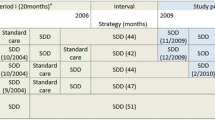Abstract
Patients undergoing an esophageal resection because of carcinoma are at risk of developing postoperative respiratory tract infections. These patients were studied with respect to preceding colonisation with gram-negative bacilli and the effect of selective decontamination (SD) in decreasing this phenomenon, thereby reducing gram-negative infections. We randomised prospectively 114 patients into a test group receiving SD-medication (n=56) and a control group receiving conventional prophylaxis. Postoperatively, all patients were admitted to the intensive care unit and mechanically ventilated. The preoperative administration of SD-medication resulted in adequate decontamination within 3–4 days in most patients, and SD could prevent gram-negative colonisation and infections effectively. Discontinuation of SD showed gram-negative (re-)colonisation, and resulted in 12 infections in 4 patients having late complications. This indicates that prolonged use in these patients might be beneficial. This new antibiotic prophylaxis proved effective, without causing an increase in bacterial resistance.
Similar content being viewed by others
References
Massarani RM, Hierholzer WJ Jr (1986) The intensive care unit. In: Bennett JV, Brachman PhS (eds) Hospital infections, 2nd edn. Little, Brown and Company, Boston/Toronto, pp 285–297
Daschner FD (1985) Nosocomial infections in intensive care units. Intensive Care Med 11:284–287
Hughes JM (1988) Epidemiology and prevention of nosocomial pneumonia. In: Remington JS, Schwartz MM (eds) Current clinical topics in infectious diseases, vol 9. McGraw-Hill, New York, pp 241–259
Craven DE, Kunches LM, Kilinsky V, Lichtenberg DA, Make BJ, McCabe WR (1986) Risk factors for pneumonia and fatality in patients receiving continuous mechanical ventilation. Am Rev Respir Dis 133:792–796
Gross Pa, Neu HC, Aswapokee P, v Antwerpen C, Aswapokee N (1980) Deaths from nosocomial infections: Experience in a university hospital and community hospital. Am J Med 68:219–223
Wenzel RP, Thompson RL, Landry SM, Russell BS, Miller PJ, Ponce de Leon S, Miller GB (1983) Hospital-acquired infections in intensive care unit patients: an overview with emphasis on epidemics. Infect Control 4:371–375
Kerver AJH, Rommes JH, Mevissen-Verhage EAE, Hulstaert PF, Vos A, Verhoef J, Wittebol P (1987) Colonization and infection in surgical intensive care patients, a prospective study. Intensive Care Med 13:347–351
Kerver AJH, Rommes JH, Mevissen-Verhage EAE, Hulstaert PF, Vos A, Verhoef J, Wittebol P (1988) Prevention of colonization and infection in critically ill patients, a prospective randomised study. Crit Care Med 16:1087–1093
Soutenbeek ChP, v Saene HKF, Miranda DR, Zandstra DF (1984) The effect of selective decontamination of the digestive tract on colonization and infection rate in multiple trauma patients. Intensive Care Med 10:185–192
Northey ML, Adess JM, Hartsuck JM, Rhoades ER (1974) Microbial surveillance in a surgical intensive care unit. Surg Gynecol Obstet 139:321–325
Thorp JM, Richards WC, Teller ABM (1979) A survey of infection in an intensive care unit: forwarned is forearmed. Anaesthesia 34:643–650
Eickhoff TC (1982) Nosocomial infections. N Engl J Med 306:1545–1546
Johanson WG, Pierce AK, Sanford JP (1969) Changing pharyngeal bacterial flora of hospitalized patients. Emergence of gramnegative bacilli. N Engl J Med 281:1137–1140
Price DJE, Sleigh JD (1970) Control of infection due to Klebsiella aerogenes in a neurosurgical unit by withdrawal of all antibiotics. Lancet I:1213–1215
Schimpff SC, Young VM, Green WH, Vermeulen GD, Moody MR, Wiernik PH (1972) Origin of infection in acute nonlymfocytic leukemia. Significance of hospital acquisition of potential pathogens. Ann Intern Med 77:707–714
Bryant LR, Kent Trinkle J, Mobin-Uddin K, Baker J, Griffen WO (1972) Bacterial colonization profile with tracheal intubation and mechanical ventilation. Arch Surg 104:647–651
Rose HD, Babcock JB (1975) Colonization of intensive care unit patients with gram-negative bacilli. Am J Epidem 101:495–501
Chow AW, Taylor PhR, Yoshikawa ThT, Guze LB (1979) A nosoco mial outbreak of infections due to multiply resistant Proteus Mirabilis, role of intestinal colonization as a major reservoir. J Intfect Dis 139:621–627
Uffelen R van, v Saene HKF, Fidler V, Lowenberg A (1984) Oropharyngeal flora as a source of bacteria colonising the lower airways in patients on artificial ventilation. Intensive Care Med 10:233–237
Johanson WG, Pierce AK, Sanford JP, Thomas GD (1972) Nosoco mial respiratory tract infections with Gram-Negative Bacilli. The significance of colonization of the respiratory tract. Ann Intern Med 77:701–706
Turck M, Stamm W (1981) Nosocomial infection of the urinary tract. Am J Med 70:651–654
Preston GA, Larson EL, Stamm WE (1981) The effect of private isolation rooms on patient care practices: Colonization and infection in an intensice care unit. Am J Med 70:641–645
Waay D van der, Berghuis-de Vries JM, Lekkerkerk-v der Wees JEC (1971) Colonization resistance of the digestive tract in conventional and antibiotic treated mice. J Hyg Cambr 69:405–411
Waay D van der (1984) The digestive tract in immunocompromised patients; importance of maintaining its resitance to colonization, especially in hospital in-patients and those taking antibiotics. A v Leeuwenhoek 50:745–761
Ledingham IMcA, Eastaway AT, McKay IC, Alcock SR, McDonald JC, Ramsay G (1988) Triple regimen of selective decontamination of the digestive tract, systemic cefotaxime and microbiological surveillance for prevention of acquired infection in intensive care. Lancet I:785–790
Weinstein RA, Kabins SA (1981) Strategies for prevention and control of multiple drug-resistant nosocomial infections. Am J Med 70:449
Barza M, Giuliano M, Jacobus NV, Gorbach SL (1987) Effect of broad-spectrum parenteral antibiotics on “colonisation resistance” of intestinal microflora of humans. Antimicrob Agents Chemother 31:723–727
Milatovic D, Braveny I (1987) Development of resistance during antibiotic therapy. Eur J Clin Microbiol 6:234–244
Tetteroo GWM, Wagenvoort JHT, Castelein A, Tilanus HW, Ince C, Bruining HA (1990) Selective Decontamination to reduce gramnegative colonisation and infections after esophageal resection. Lancet 335:704–707
Author information
Authors and Affiliations
Rights and permissions
About this article
Cite this article
Tetteroo, G.W.M., Wagenvoort, J.H.T., Ince, C. et al. Effects of selective decontamination on gram-negative colonisation, infections and development of bacterial resistance in esophageal resection. Intensive Care Med 16 (Suppl 3), S224–S228 (1990). https://doi.org/10.1007/BF01709705
Issue Date:
DOI: https://doi.org/10.1007/BF01709705




